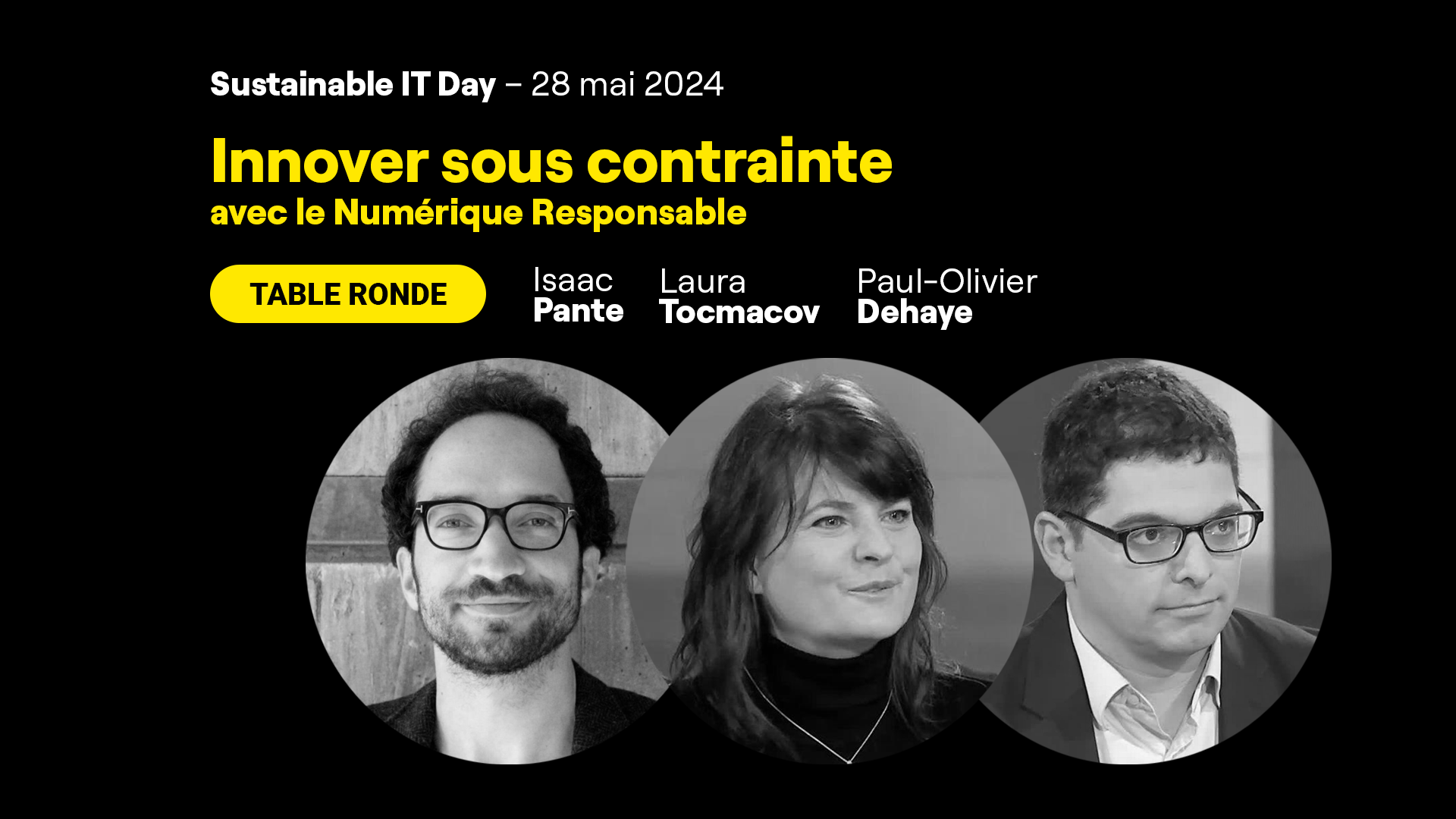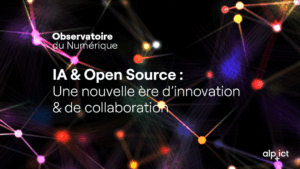
Innovating under pressure with Responsible Digital
A round table organized by Alp ICT as part of Sustainable IT Day.
The first edition of the Sustainable IT Day took place on 28 May at the Impact Hub in Lausanne. At the initiative of the Swiss Institute for Sustainable IT (ISIT-CH) and in partnership with Alp ICT, this day of conferences, round tables and workshops on the subject of Responsible Digital Technology brought together more than 150 people.
The aim of the event was to mobilize the IT community in French-speaking Switzerland to raise awareness of the digital aspect of our environmental footprint, and to share solutions and avenues for making innovation and digital technologies more sustainable and responsible.

Isaac Pante, Paul-Olivier Dehaye, Laura Tocmacov & Delphine Seitiée | Photo ©️ Micael Hautier
How can companies, technology creators, and political actors transform constraints into opportunities for sustainable and ethical digital development?
What strategies can be put in place to integrate these values while maintaining a high level of innovation and meeting societal expectations? To answer these questions, Alp ICT organised a round table on the topic of innovation under constraint. This discussion, moderated by Delphine Seitiée, brought together three experts: Laura Tocmacov, CEO of the Impact IA Foundation, Paul-Olivier Dehaye, CEO of Hestia.ai and founder of Argo GPT and Isaac Pante, Senior Lecturer and Research Fellow at UNIL and co-founder of the GameLab.
Takeaways & replay
Creativity & constraints: Constraints often stimulate innovation and creativity.
Hybridization: Collaboration between different forms of intelligence is key to maximizing innovation.
Transparency & democratization: Transparent AI that is accessible to all is crucial for equitable development.
Open source: Open source plays an important role in ensuring the fair and democratic use of AI technologies.
Influence of Silicon Valley: Switzerland and Europe must find a balance between adopting and resisting the standards imposed by Silicon Valley.
Switzerland's role: Switzerland can become a model of digital sobriety and a leader in aligning AI with fundamental rights.
Taking time: Taking the time to fully understand and integrate innovations is essential for sustainable and effective development.

Creativity born of constraint
Constraints, although limiting in appearance, can paradoxically stimulate creativity. By setting limits, we often discover innovative solutions that would otherwise be unattainable. Technical and cultural constraints can also pave the way for new approaches, with concrete examples of resource optimization and management.
" When we put constraints on ourselves and we say to ourselves, well, we go to this sandbox to put it as a constraint, we manage to go beyond things that we wouldn't have managed to do if we had given ourselves all the freedom. »
- Laura Tocmacov
The importance of hybridization
The speakers insisted on the importance of hybridization, i.e. the collaboration between individual, collective and artificial intelligence. This is essential for maximising innovation. This approach makes it possible to overcome the limits inherent in each of these intelligences. Concrete projects show how hybridisation facilitates the management of construction waste and how the integration of varied skills from the outset of projects can maximise innovation.
"For me, hybridization essentially means working on multidisciplinarity, and systematically asking ourselves who we're going to bring to the table for a discussion. "
- Isaac Pante
AI Challenges & Opportunities
Participants discussed the challenges associated with AI, including managing bias and the importance of AI transparency and democratization. It is crucial to involve citizens in the AI development process to ensure that it is aligned with fundamental rights. Open source plays an important role in ensuring the fair and democratic use of AI technologies.
"Open source is essential to ensure fair and democratic use of AI technologies. "
- Paul-Olivier Dehaye
Silicon Valley: constraint or driving force?
The discussion also focused on the influence of Silicon Valley, describing this influence as both a driver and a constraint, due to its ability to impose standards while possessing considerable resources. Silicon Valley's announcements can radically change market expectations and norms, underlining the need for Europe and Switzerland to find their own way.
"Silicon Valley gives us a feeling of simultaneity by saying, 'Here you go, now OpenAI, ChatGPT, etc. is available; you open your browser, and you're contemporary with this technology. "
- Isaac Pante
Simultaneity & contemporaneity
An interesting point raised during the discussion is the distinction between simultaneity and contemporaneity, a concept introduced by Marguerite Duras. Silicon Valley often creates an illusion of simultaneity: technologies are quickly made available, giving the impression that everyone is immediately on the same technological level. However, being truly contemporary with a technology means having fully integrated it into its context and practice. This distinction is important to understand that rapid adoption does not guarantee deep understanding, nor optimal use.
"You have to distinguish between simultaneity and being contemporary with something. "
- Isaac Pante
Switzerland as a model of digital sobriety
The speakers concluded that Switzerland has a key role to play in promoting responsible and sustainable innovation. Fragmentation and subsidiarity can be assets, enabling innovations tailored to local contexts. With its history of data protection, Switzerland could become a leader in the development of AI aligned with fundamental rights.
"Switzerland has a real card to play around... Switzerland should be the place where we discuss what is AI aligned to fundamental rights. "
- Laura Tocmacov
Taking the time to innovate
Speakers stressed the importance of taking time to innovate effectively. Innovation should not be rushed, but rather carefully thought out and executed. Taking time allows us to better understand the tools and technologies available, to integrate diverse perspectives and to develop solutions that are truly beneficial and sustainable. This approach also reduces the stress and burn-out associated with a constant race to innovate.
"You have to give people time. And that's not necessarily easy in the entrepreneurial context, but in just about every context today. "
- Isaac Pante
Innovating under constraint: experts' perspectives
The guests provided relevant perspectives on the theme "Innovating under constraint". Isaac Pante evoked the idea that constraints can act as catalysts for innovation, citing examples from art and psychology where imposed limits promote creativity and innovation. Paul-Olivier Dehaye highlighted the technical and narrative constraints in the field of artificial intelligence, stressing that small-scale logics and local approaches can sometimes surpass the large dominant models. Laura Tocmacov insisted that constraints, when well managed, can be opportunities to redefine objectives and processes, including by focusing on collaboration and alignment of AI with fundamental rights.




